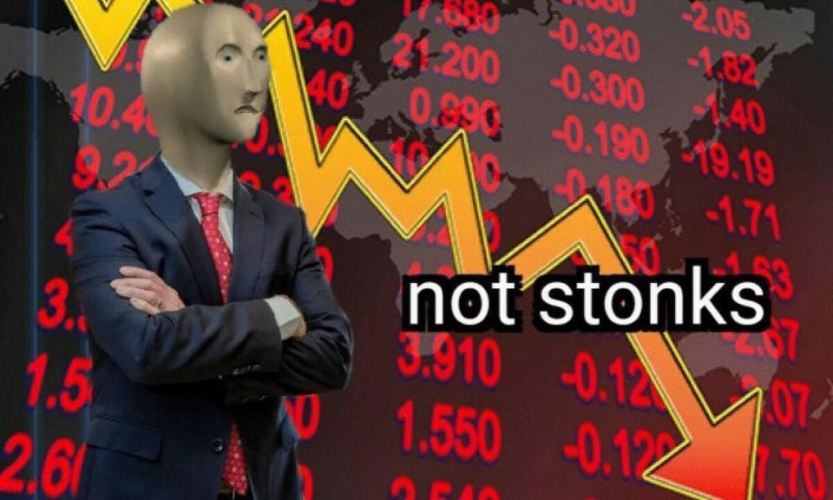Image description: In the background is a stock-exchange screen with lists of numbers in red, with an underlay of the world map in grey. In front of the stock-exchange image is a yellow trend arrow on a graph, which fluctuates but ultimately ends in a negative/downward position. Over this arrow are the words ‘not stonks’. In the left-foreground is a digital mannequin in a suit, face frowning and arms crossed.
By Millie Muroi
When the plug was pulled on the New York Stock Exchange (NYSE) on Monday, the ninth of March, it marked an attempt to placate investors’ panic. By 9:33am – three minutes after market opening – participants had sold enough shares to send the exchange plummeting by seven percent. What sparked this sudden sell-off? Was it calm before the storm? How are financial markets faring now?
First of all, let’s address the elephant in the room. At this point, you’ve been living under sweeping swathes of toilet paper if you haven’t heard about the novel coronavirus. Either that, or you’ve been knocked out in the quest to obtain the stuff that (usually) inconspicuously graces our restrooms.
After a severe commencement in mainland China, COVID-19 has come knocking in Australia, and overwhelmed South Korea, Iran, and Italy. Fears of infection have hammered spending, with consumer confidence falling to an almost six-year low. This is paired with supply-side constraints as factories close their doors and workers elect to stay home, depressing output for most goods and services. To combat anaemic growth, central banks have responded by cutting interest rates, and governments have promised stimulus packages to provide a much-needed economic injection.
What really sent share prices into a drastic nose-dive this week, though, was the beginning of pricing wars. The key players in this story are Russia and Saudi Arabia, which both rely heavily on producing oil in order to fuel their economies. Remember that COVID-19 is slumping production across the world, meaning countries need less oil to create things. This drop in demand for oil has sent the crude oil spot price spiralling downwards since January. For oil-producing economies, this spells trouble. Imagine waking up each morning and finding that your pay cheque keeps shrinking…
To combat declining revenues from these falling oil prices, OPEC (Organisation of the Petroleum Exporting Countries) had an ostensibly genius idea to cut production. By constricting the amount of oil going onto the market, they would push prices back up as the commodity was made scarcer. Theoretically, this could have worked. Production cuts during the 1973 oil crisis contributed to a 178% increase in the crude oil price by the following year. So why hasn’t it worked in 2020?
Well, before any of the cuts could be implemented, Russia threw a spanner in the works by refusing to collaborate. Sure, low oil prices hurt Russians too, but their motive partly lies in ousting the US – where heavily-indebted shale companies* cling to high-priced oil. The logic is that by allowing oil prices to plummet, Moscow will be able to diminish the market share of the United States – yes, power move right here.
Of course, OPEC wasn’t impressed by this defiance. Saudi Arabia, who spearheads the alliance, retaliated towards Russia by slashing oil prices by approximately 10%. This sent the value of oil crashing even further, rattling US shale companies, and undoubtedly ruining many fund managers’ weekends.
So, when trading opened on Monday, investors were ready – probably resembling a bunch of EDM fans before tickets for Tomorrowland go on sale. Only, they were there to sell – and fast. This sudden shedding of shares sparked circuit breakers, which temporarily halted trading when prices reach predetermined levels. This was supposed to curb panic and allow investors some time to recollect.
While the free-fall this week was significant, and economic growth continues to be suppressed, it is worth noting that stocks were at unprecedented highs before the decline. Perhaps we were situated very late-cycle, and simply waiting for a signal to sell.
Lemony Snicket once said: “if you are interested in stories with happy endings, you would be better off reading some other book”. I’ve left that warning a little late, but since COVID-19 seems yet to reach its peak, and the price-war over oil just generating steam, I have scant grounds to offer a positive outlook for our financial markets – at least in the short-term.
On the bright side, Australia is pretty good at producing wood shavings. As long as supermarket scuffles are kept subdued, our eighty-percent self-sufficiency in toilet paper production should see us through.
*Shale companies are companies that mine high-quality crude oil.

